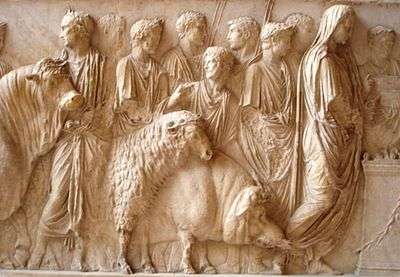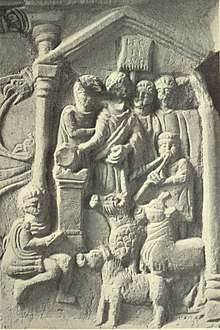Suovetaurilia
The suovetaurilia or suovitaurilia was one of the most sacred and traditional rites of Roman religion: the sacrifice of a pig (sus), a sheep (ovis) and a bull (taurus) to the deity Mars to bless and purify land (Lustratio).

The ritual is preserved in Cato the Elder's De Agri Cultura, "On Agriculture". The first step was to lead the three animals around the boundaries of the land to be blessed, pronouncing the following words:
- Cum divis volentibus quodque bene eveniat, mando tibi, Mani, uti illace suovitaurilia fundum agrum terramque meam quota ex parte sive circumagi sive circumferenda censeas, uti cures lustrare.
- "That with the good help of the gods success may crown our work, I bid thee, Manius, to take care to purify my farm, my land, my ground with this suovetaurilia, in whatever part thou thinkest best for them to be driven or carried around."
"Manius" in this passage may be an obscure minor deity, related to the Manes, or may be the equivalent of English John Doe. Then, before the sacrifice is performed, the following prayer to Mars must be made:
- Mars pater, te precor quaesoque uti sies volens propitius mihi domo familiaeque nostrae, quoius re ergo agrum terram fundumque meum suovitaurilia circumagi iussi, uti tu morbos visos invisosque, viduertatem vastitudinemque, calamitates intemperiasque prohibessis defendas averruncesque; utique tu fruges, frumenta, vineta virgultaque grandire beneque evenire siris, pastores pecuaque salva servassis duisque bonam salutem valetudinemque mihi domo familiaeque nostrae; harumce rerum ergo, fundi terrae agrique mei lustrandi lustrique faciendi ergo, sicuti dixi, macte hisce suovitaurilibus lactentibus inmolandis esto; Mars pater, eiusdem rei ergo macte hisce suovitaurilibus lactentibus esto
- "Father Mars, I pray and beseech thee that thou be gracious and merciful to me, my house, and my household; to which intent I have bidden this suovetaurilia to be led around my land, my ground, my farm; that thou keep away, ward off, and remove sickness, seen and unseen, barrenness and destruction, ruin and unseasonable influence; and that thou permit my harvests, my grain, my vineyards, and my plantations to flourish and to come to good issue, preserve in health my shepherds and my flocks, and give good health and strength to me, my house, and my household. To this intent, to the intent of purifying my farm, my land, my ground, and of making an expiation, as I have said, deign to accept the offering of these suckling victims; Father Mars, to the same intent deign to accept the offering of these suckling offering."
The original Latin of this prayer is crudely metrical and incantatory; even in Old Latin, the prayer contains many rhetorical figures such as alliteration and liberal use of merisms and antithesis. It illustrates the sing-song, metrical, and poetic format of polytheistic prayers. Cakes of bread were sacrificed along with the three animals. At the moment the sacrifices were made, the landowner was to say:
- Eiusque rei ergo macte suovitaurilibus inmolandis esto.
- "To this intent deign to accept the offering of these victims."
If favourable omens as a response to the sacrifice were not forthcoming, the landowner was instructed to redo the sacrifice and offer a further prayer:
- Mars pater, siquid tibi in illisce suovitaurilibus lactentibus neque satisfactum est, te hisce suovitaurilibus piaculo.
- "Father Mars, if aught hath not pleased thee in the offering of those sucklings, I make atonement with these victims."
If only one or two of the omens expected after the three sacrifices failed to appear, the landowner was instructed to offer an additional swine, saying:
- Mars pater, quod tibi illoc porco neque satisfactum est, te hoc porco piaculo.
- "Father Mars, inasmuch as thou wast not pleased by the offering of that pig, I make atonement with this pig."
The nature of the expected omens is not given by Cato. The omens, however, were likely determined by the art of haruspicy, the examination of the entrails, and especially the livers, of sacrificed animals for divinatory signs.
Both public and private suovetaurilias were performed in the Roman religion. Cato describes the ritual performed to purify, or "lustrate", a farm. A private rural suovetaurilia was sacrificed each May on the festival of Ambarvalia, a festival that involved "walking around the fields." Public suovetaurilias were offered at certain state ceremonies, including agricultural festivals, the conclusion of a census, and to atone for any accidental ritual errors. Traditionally, suovetaurilias were performed at five year intervals: this period was called a lustrum, and the purification sought by a suovetaurilia was called lustration.


If a temple were destroyed, the site of the temple must be purified by a suovetaurilia before a new temple could be reconstructed on the site. When the Capitolium was burnt as a result of a struggle for imperial succession in the year 69, a suovetaurilia was performed to reconsecrate the site. A public suovetaurilia was also offered to bless the army before a major military campaign. On Trajan's column, the emperor Trajan is depicted as offering a suovetaurilia to purify the Roman army. A suovetaurilia is shown on the right hand panel of The Bridgeness Slab. It was suggested that the sacrifice might have been made at the start of the building of the Antonine Wall.[2]
Some religious rites similar to the Roman suovetaurilia were practiced by a few other Indo-European peoples, from Iberia to India. The Cabeço das Fráguas inscript (found in Portugal) describes a threefold sacrifice practiced by the Lusitanians, devoting a sheep, a pig and a bull to what may have been local gods.[3] In the Indian Sautramani, a ram, a bull and a goat were sacrificed to Indra Sutraman;[3] in Iran ten thousand sheep, a thousand cattle and a hundred stallions were dedicated to Ardvi Sura Anahita.[3] Similar to the above rituals is the Greek trittoíai, the oldest known being described in the Odyssey and dedicated to Poseidon. The philosopher and historian Plutarch related in the Lives Of The Noble Greeks And Romans a story from the life of Pyrrhus about the sacrifice of a ram, a pig and a bull. The Umbrian Iguvine Tables also describe a sacrificial ritual related to the aforementioned rites.
References
- Macdonald, Sir George (1934). The Roman wall in Scotland, by Sir George Macdonald (2d ed., rev., enl., and in great part rewritten ed.). Oxford: The Clarendon press. pp. 362–365. Retrieved 11 October 2017.
- The Scottish antiquary, or, Northern notes & queries. Edinburgh: T. and A. Constable. 1890. pp. 19–25. Retrieved 28 October 2017.
- Blanca María Prósper (1999). "The inscription of Cabeço das Fraguas revisited. Lusitanian and Alteuropäisch populations in the west of the Iberian Peninsula". Transactions of the Philological Society. 97 (2): 151-184. doi:10.1111/1467-968X.00047.
Bibliography
- Watkins, Calvert. How to Kill a Dragon: Aspects of Indo-European Poetics (Oxford, 2001) ISBN 0-19-514413-9
External links
- Cato the Elder: On Agriculture (from Lacus Curtius)